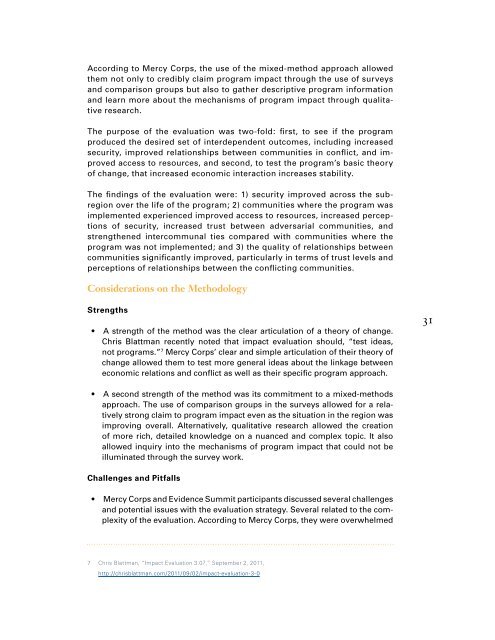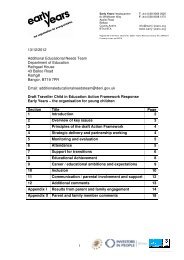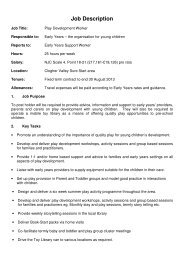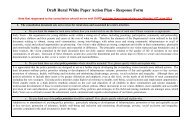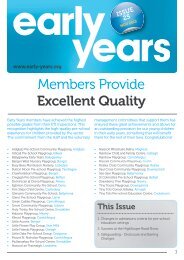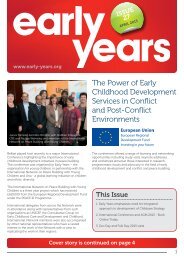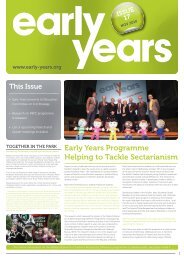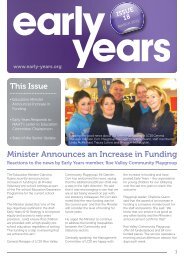Learning from Nine Examples of Peacebuilding Evaluation
Learning from Nine Examples of Peacebuilding Evaluation
Learning from Nine Examples of Peacebuilding Evaluation
Create successful ePaper yourself
Turn your PDF publications into a flip-book with our unique Google optimized e-Paper software.
According to Mercy Corps, the use <strong>of</strong> the mixed-method approach allowed<br />
them not only to credibly claim program impact through the use <strong>of</strong> surveys<br />
and comparison groups but also to gather descriptive program information<br />
and learn more about the mechanisms <strong>of</strong> program impact through qualitative<br />
research.<br />
The purpose <strong>of</strong> the evaluation was two-fold: first, to see if the program<br />
produced the desired set <strong>of</strong> interdependent outcomes, including increased<br />
security, improved relationships between communities in conflict, and improved<br />
access to resources, and second, to test the program’s basic theory<br />
<strong>of</strong> change, that increased economic interaction increases stability.<br />
The findings <strong>of</strong> the evaluation were: 1) security improved across the subregion<br />
over the life <strong>of</strong> the program; 2) communities where the program was<br />
implemented experienced improved access to resources, increased perceptions<br />
<strong>of</strong> security, increased trust between adversarial communities, and<br />
strengthened intercommunal ties compared with communities where the<br />
program was not implemented; and 3) the quality <strong>of</strong> relationships between<br />
communities significantly improved, particularly in terms <strong>of</strong> trust levels and<br />
perceptions <strong>of</strong> relationships between the conflicting communities.<br />
Considerations on the Methodology<br />
Strengths<br />
• A strength <strong>of</strong> the method was the clear articulation <strong>of</strong> a theory <strong>of</strong> change.<br />
Chris Blattman recently noted that impact evaluation should, “test ideas,<br />
not programs.” 7 Mercy Corps’ clear and simple articulation <strong>of</strong> their theory <strong>of</strong><br />
change allowed them to test more general ideas about the linkage between<br />
economic relations and conflict as well as their specific program approach.<br />
31<br />
• A second strength <strong>of</strong> the method was its commitment to a mixed-methods<br />
approach. The use <strong>of</strong> comparison groups in the surveys allowed for a relatively<br />
strong claim to program impact even as the situation in the region was<br />
improving overall. Alternatively, qualitative research allowed the creation<br />
<strong>of</strong> more rich, detailed knowledge on a nuanced and complex topic. It also<br />
allowed inquiry into the mechanisms <strong>of</strong> program impact that could not be<br />
illuminated through the survey work.<br />
Challenges and Pitfalls<br />
• Mercy Corps and Evidence Summit participants discussed several challenges<br />
and potential issues with the evaluation strategy. Several related to the complexity<br />
<strong>of</strong> the evaluation. According to Mercy Corps, they were overwhelmed<br />
7 Chris Blattman, “Impact <strong>Evaluation</strong> 3.0,” September 2, 2011,<br />
http://chrisblattman.com/2011/09/02/impact-evaluation-3-0


